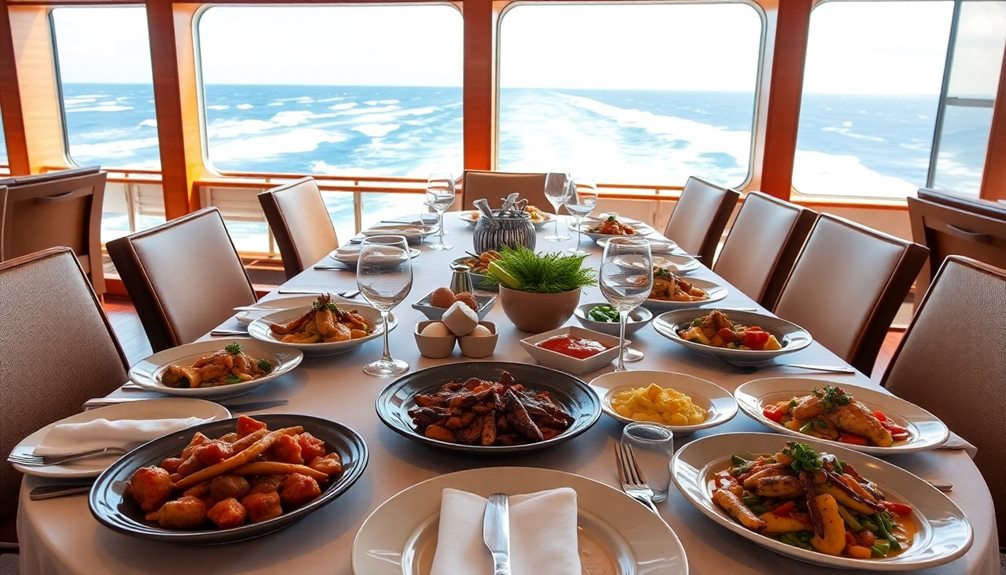To handle dietary restrictions on a cruise, start by informing the cruise line at least 45-90 days before your departure. Communicate your needs to the head waiter upon boarding, and consider providing a printout of your restrictions for clarity. Explore dining options like the main dining room or specialty restaurants, and always ask for ingredient lists to avoid allergens. During buffets, inquire about safe choices and request clean utensils to prevent cross-contamination. For shore excursions, notify the team about your dietary needs. There's much more to guarantee a smooth sailing, so explore helpful tips to maximize your experience.
Key Takeaways
- Communicate dietary restrictions during booking and submit needs 45-90 days prior to sailing for proper meal preparation.
- Speak with the head waiter upon boarding to confirm and clarify your dietary requirements.
- Utilize dietary cards and provide a printout of restrictions to staff for clear communication.
- Engage with culinary staff early to address food allergies and request ingredient lists for safe dining options.
- Research cruise lines that specialize in dietary accommodations and confirm their policies before booking.
Booking Your Cruise

When planning your cruise, it's important to communicate any dietary restrictions right from the start. This guarantees the cruise line can accommodate your needs effectively. During the booking process, inform your travel agent or directly reach out to the cruise lines about your dietary requests. Providing this information early allows them to prepare suitable options for your meals.
Additionally, consider researching affordable cruise lines that offer great dining options to fit your dietary needs.
Make sure to submit any special dietary needs at least 45 to 90 days before sailing. Some meal preparations require advance notice, and this time frame helps the onboard staff manage their inventory and meal planning. Many cruise lines offer online forms, like the Cruise Personalizer, which let you detail your dietary preferences when booking.
Don't forget to confirm your dietary requirements as your departure date approaches. This step guarantees that your needs are flagged in the dining room system, making it easier for the staff to serve you appropriately.
Research cruise lines that specialize in dietary accommodations to find one that meets your specific needs, whether you're looking for vegan, gluten-free, or kosher options. Taking these steps will help you enjoy your cruise without worrying about your meals.
Communicating Dietary Needs
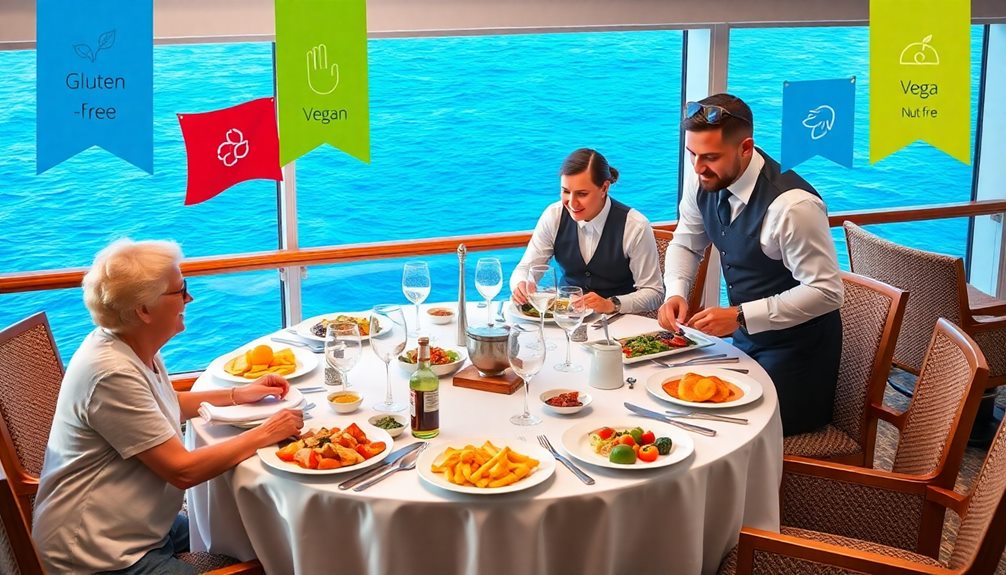
To guarantee your dietary needs are met while cruising, it's vital to communicate them clearly and early. Inform the cruise line of your dietary restrictions at least 45 to 90 days before sailing. This allows them to make the necessary accommodations.
Upon boarding, locate and speak with the head waiter or dining room manager. Confirm that your dietary needs are flagged in the dining room system to make sure your requests are recognized.
If your dietary restrictions are complex, consider providing a printout to the staff. Communicate these needs to the waitstaff at each meal for consistency. Use dietary cards or direct communication to specify your restrictions to the kitchen staff, and don't hesitate to request ingredient lists for particular dishes.
Engaging with the culinary staff early in your cruise fosters a supportive dining environment. Let them know about any food allergies so they can prioritize your needs throughout your trip.
Dining Options Onboard
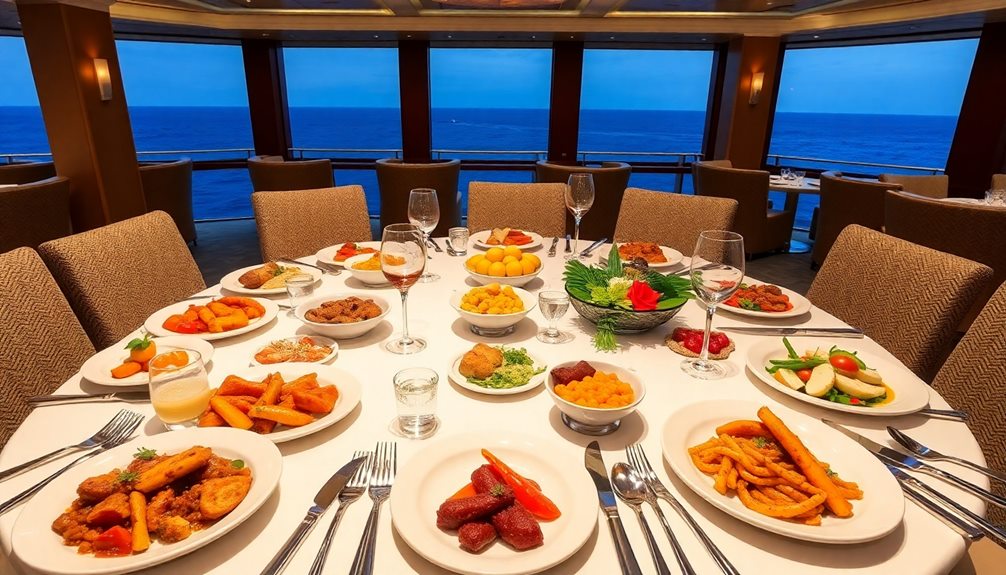
Explore the diverse dining options onboard a cruise, where you'll find something to satisfy every palate, including those with dietary restrictions. Cruise lines understand that guests have unique dietary needs and offer a variety of dining experiences to accommodate special diets.
| Dining Options | Features | Tips for Dietary Needs |
|---|---|---|
| Main Dining Room (MDR) | Special menus and flexible dining | Communicate your needs to the head waiter upon boarding. |
| Specialty Restaurants | Unique cuisine; advance notice may be required for food requests | Inquire about dietary accommodations when making reservations. |
| Buffet | Variety of options | Be proactive; ask staff about hidden ingredients. |
Daily menus are available for review, allowing you to request ingredient lists to align meals with your dietary restrictions. Maintaining consistent dining times can enhance your experience, ensuring personalized service. For a seamless journey, don't hesitate to make food requests early and often. Bon appétit!
Menu Modifications
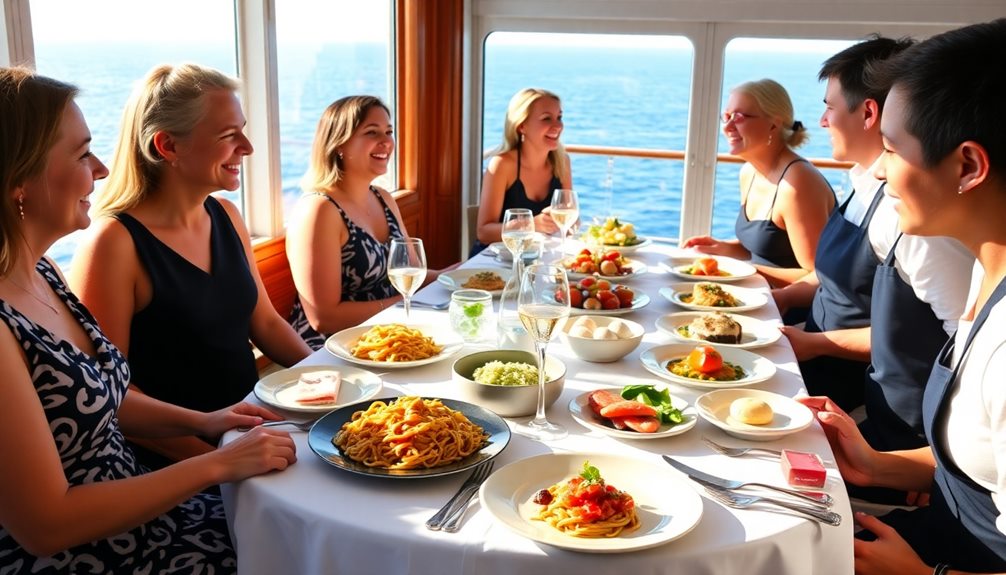
To enjoy your meals on a cruise, it's essential to communicate your dietary needs clearly.
Speak with the head waiter as soon as you board to guarantee they note any necessary modifications in the dining system.
Communicating Dietary Needs Clearly
Effectively communicating your dietary needs is essential for enjoying a worry-free cruise experience. Upon boarding, make it a priority to speak with the head waiter about your dietary restrictions. This initial conversation sets the tone for the rest of your trip.
For more complex needs, consider providing a written printout outlining your restrictions. This guarantees all staff are informed and can make necessary menu modifications.
Don't hesitate to request ingredient lists for specific dishes. This helps you identify potential allergens and facilitates personalized meal adjustments. The head waiter is well-equipped to modify sauces and dishes based on available ingredients, tailoring meals to meet your dietary needs.
Establishing consistent dining times and sticking with the same waiter can also enhance your experience. This approach reinforces your dietary requirements and allows for better meal customization throughout the cruise.
Personalizing Menu Choices Effectively
Once you've communicated your dietary needs, the next step is personalizing your menu choices to confirm every meal aligns with your restrictions. Here's how to make effective menu modifications for your special needs:
- Communicate with the Head Waiter: Upon boarding, inform the head waiter about your dietary restrictions so they can flag your needs in the dining system. This confirms your meals are prepared accurately.
- Provide Documentation: If your dietary restrictions are complex, bring a printout detailing them. This makes it easier for the dining room staff to understand and comply with your requests.
- Utilize Specialty Restaurants: For a tailored dining experience, consider dining at specialty restaurants. Just be sure to give advance notice of your dietary requirements to allow for proper meal preparation.
If you notice any discrepancies with your meal, report them promptly to the waitstaff. Quick corrections can help avoid any potential health risks.
Buffet Dining Strategies
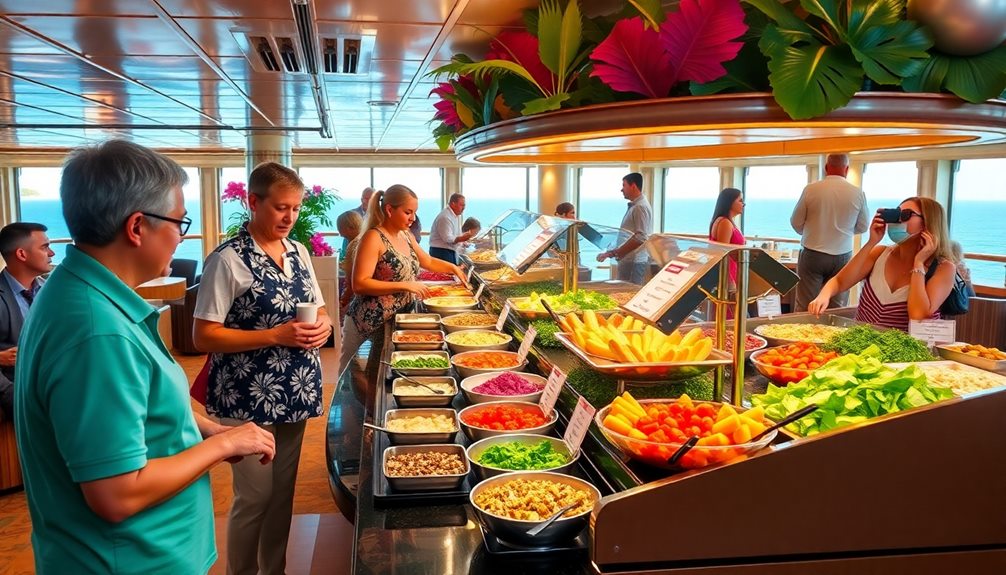
When you hit the buffet, make sure to identify safe food options that align with your dietary restrictions.
Communicating your needs to the staff is essential, so don't hesitate to ask for new gloves and utensils to prevent cross-contamination.
Safe Food Identification
Dining at a buffet can be a delightful experience, but managing dietary restrictions requires some strategies for safe food identification. To guarantee you make safe food choices, keep these tips in mind:
- Engage with the chefs: Talk to those wearing tall hats. They can clarify ingredients and help you navigate your dietary restrictions effectively.
- Request fresh utensils: Always ask staff to use new gloves and utensils when serving your food. This step is essential to avoid cross-contamination, especially if you have food allergies.
- Look for gluten-free sections: Some buffets offer dedicated gluten-free areas. While these may be limited, always verify with the staff before selecting items to confirm safety.
Additionally, don't hesitate to consult the restaurant manager for assistance. They can help you identify safe dishes and address any concerns regarding ingredient labeling at the buffet.
Cross-Contamination Prevention
Managing dietary restrictions at a buffet not only involves safe food identification but also requires vigilance against cross-contamination.
To protect your special dietary requirements, don't hesitate to request assistance from the wait staff. They can guide you to safe dishes and help minimize risks associated with cross-contact.
Always ask staff to use new gloves and utensils when serving your food. This simple step can notably reduce the chance of allergens mixing with your meal.
Look for dedicated stations within the buffet that cater to specific dietary needs, like gluten-free or allergen-free options, as these are designed to limit cross-contamination.
Inquire about preparation methods for buffet items to verify they're free from allergens and safe for your medical needs. If you're unsure, ask for ingredient lists to make informed choices.
Consider dining during off-peak hours when the buffet is less crowded. This gives you more direct access to the wait staff and a better chance to verify your food is prepared according to your dietary restrictions.
With these strategies, you can enjoy your buffet dining experience while keeping cross-contamination at bay.
Communicating Dietary Needs
Effectively communicating your dietary needs at a buffet can greatly enhance your dining experience. To guarantee you enjoy safe and delicious meals, follow these strategies:
- Engage with the Chefs: Seek out chefs, identifiable by their tall hats, and discuss your dietary restrictions. They can guide you to specific food options that meet your needs.
- Request New Utensils: When selecting food, ask staff for new gloves and utensils to prevent cross-contamination. This simple step helps guarantee that your meal is safe.
- Inspect Buffet Offerings: Take your time to carefully inspect the buffet. Since labeling can be unclear, don't hesitate to ask staff for ingredient lists or assistance in identifying safe dishes.
If you have specific dietary restrictions, consider visiting the buffet during less busy times. This allows staff to dedicate more attention to your requests, which MUST be received to guarantee compliance with your needs.
Communicating clearly with the restaurant manager can also help you find options in the main dining room that align with your dietary preferences.
Enjoy your cruise while prioritizing your health!
Shore Excursion Preparedness
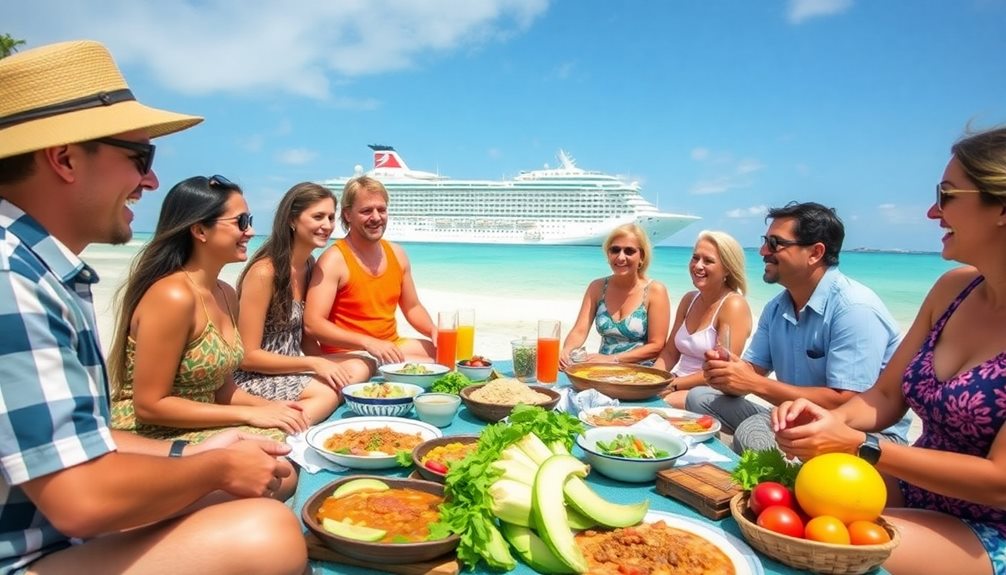
When planning shore excursions, it's crucial to prepare for your dietary restrictions to guarantee a smooth experience. Start by notifying the shore excursions desk about your needs early on, making sure they can accommodate you during your trips. Research local dining options beforehand to find restaurants that cater to your specific dietary restrictions.
Create a note in the local language that details your dietary needs. This will facilitate communication with restaurant staff and help avoid any misunderstandings. Before booking excursions that include meals, confirm menu options and the availability of safe food.
Engage with local guides to learn about food preparation practices and potential cross-contamination risks. This proactive approach will enhance your overall dining experience while keeping your health a priority.
Here's a handy table for your reference:
| Action Item | Description | Importance |
|---|---|---|
| Notify Shore Excursions Desk | Inform them of dietary needs early | Guarantees proper accommodations |
| Research Local Dining Options | Identify restaurants that cater to needs | Prevents food-related issues |
| Prepare Communication Note | Write dietary restrictions in local language | Enhances understanding with staff |
| Confirm Menu Options | Verify safe food availability | Avoids surprises during meals |
| Engage Local Guides | Learn about food prep and cross-contamination risks | Informed dining choices |
Researching Cruise Lines
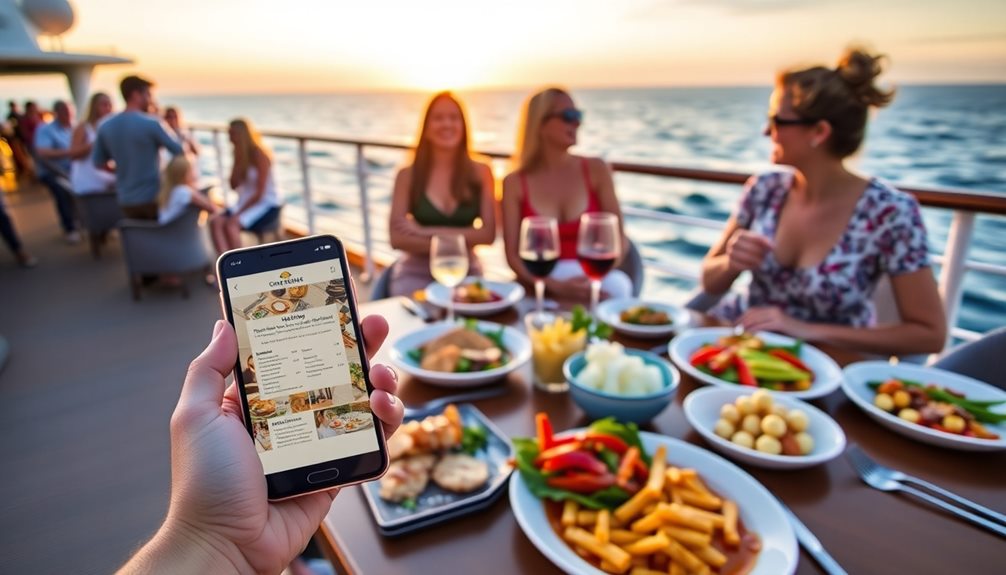
Finding the right cruise line is key to ensuring your dietary needs are met while you enjoy your vacation. Start by researching cruise lines that specifically accommodate dietary restrictions. Lines like Royal Caribbean offer options for food allergies, gluten-free, and kosher meals, but be sure to give them advance notice.
Additionally, many cruise lines have made strides in providing nutritious meal options suitable for various dietary preferences, similar to how newborn feeding options are tailored for ideal nourishment.
To streamline your search, consider these steps:
- Explore Cruise Line Websites: Check their dietary policies and menu offerings. This gives you detailed information on how they cater to specific needs.
- Seek Recommendations: Talk to fellow travelers who've cruised with dietary restrictions. Their insights can highlight lines that excel in accommodating various needs.
- Look for Specialized Options: Consider cruises focused on particular diets, like vegan or wellness itineraries, to better align with your preferences.
Packing Essentials

Packing for a cruise with dietary restrictions requires careful consideration to guarantee you're prepared for any situation. Start by packing a minimum of two auto-injectors if you have food allergies. This guarantees you have quick access to emergency medication at all times.
Create a detailed list of your dietary restrictions and include a printout of any medical prescriptions to assist onboard staff in accommodating your needs.
Pack a selection of non-perishable, allergy-safe snacks like protein bars, nuts, or dried fruits for excursions or when onboard options may not meet your requirements. It's smart to familiarize yourself with the cruise line's regulations about bringing food onboard, so you can pack accordingly and avoid complications during boarding.
Don't forget your personal care items! Guarantee lotions and shampoos are allergy-safe and contained in travel-sized containers.
You should also discuss your dietary needs with your travel agent days in advance to guarantee smooth sailing. By taking these steps, you'll enjoy your cruise with peace of mind, knowing you're well-prepared for any dietary challenges that may arise.
Conclusion
Maneuvering dietary restrictions on a cruise can feel like steering a ship through choppy waters, but with the right preparation, you can sail smoothly. By booking wisely and communicating your needs, you'll reveal a treasure trove of dining options. Think of each meal as an adventure, where every bite is a new destination. Embrace the journey, and remember that with a bit of planning, you'll savor every moment on board, turning potential obstacles into delightful experiences.
Alfons is the visionary leader and driving force behind Voyager Info’s success. As the Editor in Chief, he brings a wealth of experience and an unwavering passion for travel to the helm of our cruise-centric platform.
With a lifelong fascination for exploring new horizons, Alfons discovered his love for the ocean and cruising at a young age. From sailing across pristine Caribbean waters to embarking on daring expeditions to far-flung destinations, he has amassed a treasure trove of first-hand experiences in the world of cruising.

